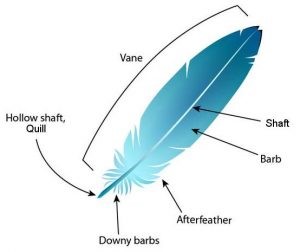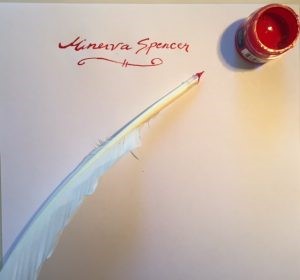I have always loved the look of quill pens and have often wondered what it was like to write with one. When you see the beautiful documents and letters people wrote with quills it is awe inspiring:

If you read historical romance (and why wouldn’t you?!) you may have noticed that people often faff around with quills. It also seems to have been an excellent way to do a little flirting.
For example: the heroine mashes or splits the end of her quill and then requires some hunky hero to trim the quill with his pen knife.
Yeah, you know what I’m talking about….
It seems to me that people back then really liked to paint other people with quills.
Here’s what I think these four folks below are thinking

coat is DREAMY!


Parts of a Feather
In case you are interested in learning something new from this post!

Anyhow, I’ve always saved the large feathers my turkey Wiccus likes to molt almost every year. I’ve also collected a few goose feathers over the past few years, although they don’t seem to have an all-over molt like chickens and turkeys.


Some of the feathers were out in the weather and had become pretty dirty so I gave them a good scrubbing. Feathers are durable and get wet all the time. Birds usually preen them with natural oils to make them water-resistant so some of these feathers were remarkably clean. Those that had been left out in the sun and elements were harder to wash. You can give them a vigorous scrubbing with a brush in warm, soapy water if necessary.
Once they’ve dried they’ll be all nice and fluffy again!
After reading various “how-to” instructions I decided to try my hand at cutting my own quill.
Now, before everyone at home rushes out to try this (as I know you all WILL) please be warned that cutting a quill is dangerous, tricky business. I’ve seen how durable a bird’s plumage is, so I don’t know why I was so surprised a feather would be so hard to cut—but they are!
But before I proceed I need to make a confession. Cutting and shaping feathers was not only dangerous, it was damned near impossible. So, I ended up cheating a little. You can read about that and see pictures below.
Here’s What You Will Need (Purists)
- A feather. (PLEASE don’t buy a feather from a hobby store as most of them have been taken from birds in inhumane conditions rather than voluntarily donated. Take a look on Craigslist as people often just save them and give them away. I have bags of feathers and I’m always glad to share!)
- a cutting board (I used an old plastic board that I keep on hand for cutting non-food items)
- a thin tipped marker
- scissors
- a VERY sharp Xacto knife (this is important! The feathers are hard enough to cut as it is)
- safety glasses- you scoff, but an Xacto tip snapped off and I was glad I was wearing glasses. Glad.
Or if You’re Like Me…
- metal nibs
- glue
- embroidery floss/thread
HINT: if you soak the end of the feather in water overnight it will be a little easier to cut, but still difficult.
Anyhow, first you want to cut the end of the feather:

See how I’ve cut it straight. This is a tricky process as it is really easy to split the feather if you apply too much pressure. A split tip is a big deal if you are going to be a purist and hand carve your nib but not so important if you are a CHEATER. Like me…
Once you’ve cut the end off you can always clean the fluff from the center of the feather if you like.
Hold the quill the way you will want to hold it to write. Now, the truth is that actual quill pens were mostly stripped of their barbs (the fluffy part that makes the feather so pretty). Apparently they did this so the pen was easier to handle. I leave the barbs on my quills although I will trim them up if the feather has been damaged.
Anyhow, you want to make sure you hold the pen in the position you will use to write before you draw your marks.
There is no shortcut to carving. You basically draw the lines of the nib onto the feather:

Start shaping with your Xacto knife. I recommend cutting less and then slowly whittling toward the line. Here is a picture of the shape you want to end up with:

Once you’ve shaped the nib you will use the Xacto to make a split in the writing tip. Here is a picture of the nib. You can’t see the split because I’m not skilled at taking pictures…. Anyhow, you just use the tip of the Xacto to make the cut. It’s probably the easiest of the cuts since you can do it by pressing the nib onto the cutting board.

Here are some cool little pots of different colored ink I ordered from a hobby store:

Okay, no laughing–here is a sample of my writing with my nifty new quill pen!

I have to confess that took a while. If writing a book with a quill was the only way to get the job done I’m not sure I could do it…
Okay, if you’ve stuck around until this point I can now show you the cheater’s way.
You can order yourself some of these little guys:

Again, I ordered mine from Dick Blick, which definitely had the biggest selection and best price. The only reason I ordered 2 is because I have feathers that really vary in diameter. You can’t tell from the picture, but the top nib is a lot narrower than the lower one. So, you’re going to cut the tip off, just like you did above, but this time you will make a slit in the quill. Make it long enough to accommodate the base of the nib. You can use scissors on this because it doesn’t matter if the cut is really clean.

Clearly you’re going to have to do something to secure the nib in the feather. Here is a use for all that embroidery thread you have just lying around!
Okay, so maybe you’ll have to go out and buy some.

Start wrapping the thread around the nib end and work down the feather. Make sure to leave enough of the tail end to tie with the strand you are using to wrap.
See below how I’ve tied the knot and cut the thread. I’ve done it beneath the quill so it won’t interfere with your fingers when you hold it.
Take your glue of choice (I’m using Gorilla Glue here) and coat all the thread.
Once you’ve covered it on all sides you need to leave it to dry or you will have a quill pen stuck to your hand for the REST of your life (but you knew that, didn’t you?)
When it has completely dried you can trim the threads or tie them into a bow or whatever floats your boat. Sometimes I leave them, sometimes I cut them.

Here is a hand-carved quill, an inkwell from our Asian travels, an ARC of NOTORIOUS, and a 17th century secretary desk beneath it all!

The cure for a willful wife . . .
Drusilla Clare is full of opinions about why a woman shouldn’t marry. But that doesn’t stop the rush of desire she feels each time her best friend’s brother, notorious rake Gabriel Marlington, crosses her path. So imagine her dismay when she finds herself in the clutches of a scoundrel, only to be rescued by Gabriel himself. And when Gabriel’s heartless–and heart-pounding–proposal comes, it’s enough to make Dru’s formidable resolve crumble . . .
. . . is a smitten husband.
She’s sharp-tongued, exasperating–and due to one careless moment–about to become his wife. Still, something about Drusilla has Gabriel intrigued. First there’s the delicious flush of her skin every time she delivers a barb–and then the surprisingly sensual feel of her in his arms. Gabriel even finds himself challenged by her unusual philosophies. And when he discovers a clandestine rival for Dru’s affection, his temperature flares even hotter. But the real threat to their happiness is one neither of the newlyweds sees coming. If they’re to save their future–and their very lives–they’ll need to trust in each other and their growing love.
(Reprinted with permission from Kensington Books)













